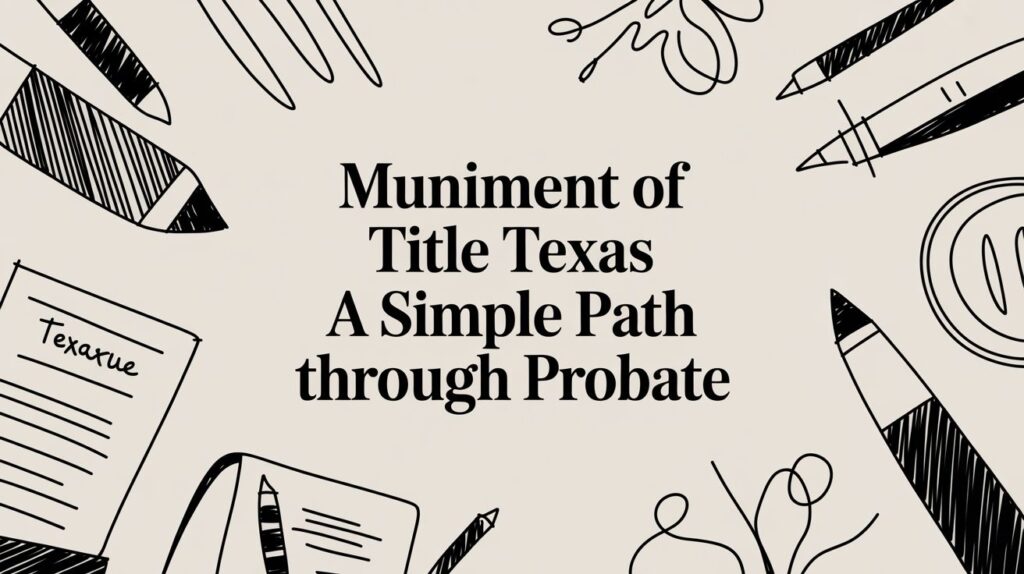If you’re wondering, where can I get an application for probate in Texas?, you’re not alone. Thousands of people each year face the overwhelming task of navigatingprobate court, often while grieving the loss of a loved one. The process can seem like a maze of paperwork, deadlines, and legal jargon—but it doesn’t have to be.
This comprehensive guide will walk you through exactly where and how to get an application for probate in Texas, explain what the court requires, and help you understand the deeper legal process behind it. We’ll explore not only where to find the forms, but how to use them, common pitfalls to avoid, and real-life examples of how getting it right—or wrong—can affect everything.
Let’s dive into the basics first, then dig into the legal and procedural insights that truly matter.

What Is a Probate Application in Texas?
Before we answer where can I get an application for probate in Texas, let’s talk about what that application actually is.
The application for probate is a formal legal document filed with a Texas probate court to begin the legal process of administering a deceased person’s estate. Depending on the type of probate you’re seeking—whether independent administration, muniment of title, or letters of administration—this application will vary slightly, but the purpose remains the same: to notify the court that someone has passed away and ask for legal authority to manage their estate.
This application is usually the first step in any probate process in Texas.
Where Can I Get an Application for Probate in Texas?
Now, for the central question: where can I get an application for probate in Texas? The answer depends on whether you want to do it yourself, have an attorney assist, or go through your local court.
Option 1: County Probate Court Website
Every Texas county with a probate court provides access to probate forms through its official website. For example:
- Harris County Probate Court offers downloadable probate packets and filing guidelines.
- Dallas County Probate Courts provide forms for applications, notices, and inventories.
- Travis County Probate Court has a helpful probate procedures manual and templates.
Visit your county’s website and look for the probate or county clerk section. That’s where you’ll usually find forms labeled:
- Application for Probate of Will
- Application for Letters Testamentary
- Application to Determine Heirship
- Application for Muniment of Title
Just make sure the forms are updated and specific to your county—requirements vary across jurisdictions.
Option 2: Texas State Law Library
The Texas State Law Library provides a wealth of legal information and even sample forms for probate applications. You can visit their website or contact them directly for guidance. This is a great resource if you want to educate yourself before filing but aren’t sure where to start.
Option 3: Through a Licensed Texas Probate Attorney
If you’re working with an attorney, they will typically prepare and file the probate application on your behalf. This is ideal if you’re dealing with a contested estate, unclear heirship, or valuable property. An attorney ensures you use the correct form, include all required information, and file it correctly with the court.

Option 4: Physical Visit to the County Clerk’s Office
Yes, you can still walk into your local county clerk’s office and request an application for probate in person. Some counties offer printed forms and may provide brief procedural guidance, though they can’t give legal advice.
Wrong Texas Probate Form Caused a Six-Month Delay
Consider Melanie from Fort Worth. After her mother passed, she downloaded what she thought was the correct probate form from an online source. She filled it out, filed it with the court—and was promptly rejected. Why? She used a generic form not accepted by Tarrant County Probate Court, which had its own specific format.
Melanie had to start over, costing her six months of delays and multiple court dates. Her story is a reminder that knowing where to get an application for probate in Texas is only part of the process—knowing which form to use is equally important.
Which Type of Probate Application Do You Need?
Not all probate applications are created equal. Let’s walk through the most common types of applications and when to use each one.
Application for Probate of Will and Letters Testamentary
Use this if the decedent left a valid will and you are named as executor. You’re asking the court to formally admit the will into probate and authorize you to manage the estate. This is the most common probate application filed in Texas.
Application for Muniment of Title
This streamlined option is available if there’s a valid will, no unpaid debts (other than a mortgage), and no need for estate administration. It essentially acts as a court-approved transfer of property titles without opening full probate.
Application for Letters of Administration
If the decedent died without a will, this is the form to use. You’ll also need to request a determination of heirship, which adds another layer of complexity and court involvement.
Application for Small Estate Affidavit
If the estate is worth less than $75,000 (excluding homestead), you might qualify for this simplified process. It requires a different set of forms but serves as an alternative to formal probate.
Understanding which type of application applies to your situation is key to choosing the right form.
What Information Do You Need to Complete the Probate Application?
The application for probate in Texas isn’t just a one-page form. It requires detailed information about:
- The decedent (name, date of death, address)
- Date and location of death
- Whether there’s a will
- List of known heirs or beneficiaries
- Description of estate assets (real estate, accounts, etc.)
- Name and contact information of the applicant
- Jurisdiction (why you’re filing in this county)
You’ll also need a certified copy of the death certificate and, in most cases, the original will.
Some counties require supporting affidavits, self-proving affidavits, or waivers of citation from heirs. This is why many people seek legal help even for “simple” estates.
Filing the Application: Step-by-Step Court Requirements
Once you’ve located the correct form and filled it out, the next step is filing it with the appropriate probate court in the county where the deceased resided.
Step 1: File the Application
You can file in person, by mail, or through your county’s e-filing portal. Texas now uses eFileTexas.gov for most electronic court filings, including probate. Your application will be assigned a cause number and go into the court docket.
Step 2: Set a Hearing Date
After filing, the court will schedule a hearing. You’ll receive notice of the hearing date, and depending on the county, you may be required to appear in person or via Zoom.
Step 3: Notice to Heirs and Interested Parties
Texas law requires notice to certain parties—usually other heirs or beneficiaries. In some cases, you may also need to publish notice in a newspaper or file notice with the county clerk.
Step 4: The Probate Hearing
At the hearing, you’ll testify under oath about the decedent, the will, and your qualifications as executor. If all goes well, the judge will sign an order admitting the will to probate and issue Letters Testamentary or Letters of Administration.
Step 5: File the Inventory
Within 90 days, you must file a full inventory of the estate with the court—unless you file an affidavit in lieu of inventory under Texas Estates Code 309.056.
Common Mistakes When Filing a Probate Application in Texas
Now that you know where to get an application for probate in Texas and how to file it, let’s talk about common mistakes that can derail the process:
- Using outdated or incorrect forms
- Filing in the wrong county
- Failing to provide proper notice to heirs
- Not including the original will
- Incorrect spelling of names or property descriptions
- Failing to appear at the probate hearing

Each mistake can result in delays, rejection, or even dismissal of your case. In some counties, you may be required to refile from scratch.
Should You Use an Attorney to File Your Probate Application?
While it’s legal to represent yourself in some probate cases, Texas courts often require legal representation when you’re acting on behalf of an estate—not just yourself.
If you’re the named executor or seeking appointment as administrator, many probate courts will not accept filings from non-attorneys. That’s because the estate is considered a separate legal entity, and representing it without a license may be considered the unauthorized practice of law.
Hiring an attorney may also be essential if:
- The will is contested
- There’s no will at all
- There are multiple heirs or family conflicts
- The estate includes debt or complex assets
Final Thoughts: Where Can I Get an Application for Probate in Texas?
So, where can you get an application for probate in Texas? From your county probate court, the Texas State Law Library, your local county clerk’s office, or through a licensed attorney who knows the ins and outs of Texas probate law.
But just getting the form isn’t enough. You need to know which form to file, how to complete it properly, and how to follow through with the court’s procedural requirements. Missteps can cost you time, money, and peace of mind.
Whether you’re a surviving spouse, adult child, or a close family friend trying to handle someone’s final affairs, knowing where to get the probate application—and how to use it—is the first step to navigating probate with confidence.








